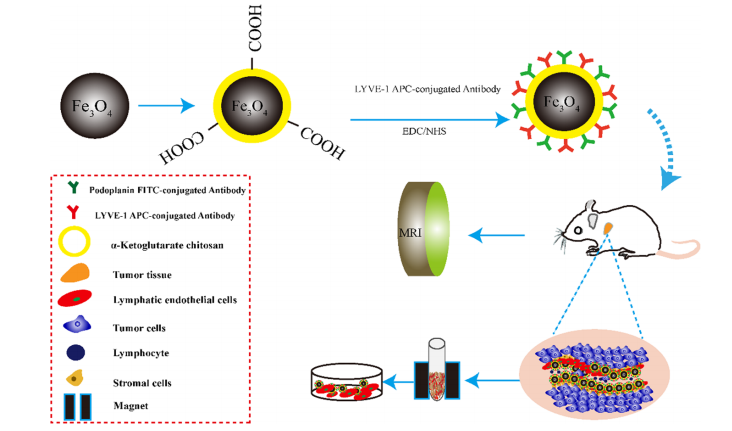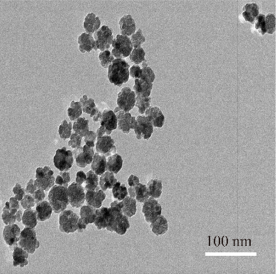文献:A Dual Targeting Magnetic Nanoparticle for Human Cancer Detection
文献链接:https://xueshu.baidu.com/usercenter/paper/show?paperid=1k270tw0jp140pk0ds7c0x00au136868&site=xueshu_se
作者:Siwen Wu, Xiyu Liu, Jian He, Huiling Wang, Yiqun Luo, Wenlin Gong, Yanmei Li, Yong Huang,
Liping Zhongand Yongxiang Zhao
原文摘要:Malignant tumors are a major threat to human life and high lymphatic vessel density is often associated with metastatic tumors. With the discovery of molecules targeted at the lymphatic system such as lymphatic vessel endothelial hyaluronan receptor 1 (LYVE-1) and Podoplanin, many studies have been performed to determine the role of lymphatic endothelial cells (LECs) in tumor metastasis. However, disadvantages such as non-specificity and high cost limit their research and diagnostic applications. In this study, Fe3O4@KCTS, a core-shell type of magnetic nanoparticles, was prepared by activating Fe3O4 with carbodiimide and cross-linking it with α-ketoglutarate chitosan (KCTS). The LYVE-1 and Podoplanin antibodies were then incorporated onto the surface of these magnetic nanoparticles and as a result, dual-targeting magnetic nanoprobes were developed. The experimental tests of this study demonstrated that a dual-targeting magnetic nanoprobe with high-purity LECs from tumor tissues was successfully developed, providing a basis for clinical application of LECs in colorectal cancer treatment as well as in early clinical diagnosis using bimodal imaging
Fe3O4纳米颗粒具有良好的磁响应性,可作为磁共振成像(MRI)的造影剂,增强图像对比度;其表面可进行修饰,如与聚乙二醇等结合,形成稳定的复合物,将化合物负载在其表面或内部,实现靶向给药,提高化合物在目标部位的浓度,增强效果;利用其磁性,在外加磁场作用下,可快速地分离特定细胞,在细胞生物学研究有重要应用。基于此 该文献研究利用碳二亚胺激活四氧化三铁,并与α-酮戊二酸壳聚糖(KCTS)交联,制备了核壳型磁性纳米颗粒Fe3O4@KCTS。然后将LYVE-1和波多普兰抗体并入这些磁性纳米颗粒的表面,从而开发出了双靶向磁性纳米探针。过程如下:

图:fe3o4@KCTS-LECs-双抗体磁性纳米颗粒示意图
Fe3O4@KCTS-LECs双抗体磁性纳米探针的制备
量取一定量预先合成好的Fe3O4介孔磁性纳米材料,将其添加至盛有适量蒸馏水的洁净容器之中。随后,利用温和且持续的搅拌操作,确保Fe3O4介孔磁性纳米材料能够均匀地分散在蒸馏水中,形成稳定的分散体系。接着,称取适量的KCTS-LECs双抗体,并缓慢地将其加入到上述分散体系内。在室温条件下,开启磁力搅拌装置,使其以适宜的转速持续搅拌反应。Fe3O4介孔磁性纳米材料与KCTS-LECs双抗体之间会逐步发生特异性的结合与相互作用,从而构建起具有特殊功能的磁性纳米探针结构。反应结束后,将一块强力磁铁紧密贴近容器外壁,磁性纳米探针会在磁场的作用下迅速向磁铁所在位置聚集,从而实现与反应溶液的有效分离。分离完成后,去除上清液,接着使用新鲜的蒸馏水对磁性纳米探针进行反复多次的洗涤操作,目的在于彻底清除掉可能残留的未反应物质、杂质以及副产物等。最后再次将清洗干净的磁性纳米探针重新分散于适量的蒸馏水中,通过温和的搅拌或超声处理等手段,确保其均匀分散,至此,便成功制备得到了Fe3O4@KCTS-LECs双抗体磁性纳米探针。

图:四氧化三铁纳米探针的透射电子显微镜图像
结论:Fe3O4参与制备的双靶向磁性纳米探针具有较高的生物安全性和稳定性。该探针可以与特定的靶分子结合。通过结合自制磁珠定制的双抗体涂层使纯LECs分离,减少了分选时间,提高了细胞活性。此外,fe3o4@KCTS-LECs-双抗体磁性纳米颗粒可应用于体内荧光/Mr分子成像。

 2025-08-18 作者:ZJ 来源:
2025-08-18 作者:ZJ 来源:

